DOES AN AFRICAN GREY PARROT FIT IN WITH YOUR LIFESTYLE?
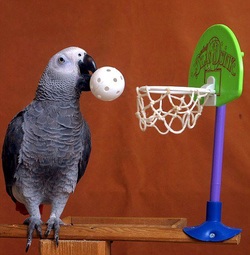
An African Grey parrot is one of the most intelligent birds we know. It needs lots of affection, freedom of movement, enough opportunities to keep occupied and regular contact with a person it knows and trusts. Frequent and long hours of being left alone combined with the restriction of movement in a cage are very harmful to parrots. Loneliness can make these birds sick, It can also trigger aggressive behaviour or cause them to pluck their own feathers. An African Grey should be included into the family and allowed to be part of family life.
If you want to do an African Grey justice you should ask yourself the following questions:
If you want to do an African Grey justice you should ask yourself the following questions:
- * Do you spend several hours of the day away from home, is there another family member who is willing to pay attention to your bird while you are not there?
- * Do you have enough patience to get through the period of adjustment, which may last for some time, without getting discouraged?
- * Will you be able to accept it if the parrot becomes more attached to another family member?
- * Can you put up with the mess if your parrot leaves droppings here and there and damages wallpaper or furniture? Although it is possible to limit dirt and damage, you cannot prevent them altogether!
- * Are you willing to allow your parrot lots of out of the cage time?
- * Would you know what to do with your bird if you were to take a vacation or needed to stay in hospital?
- * An african Grey needs concientious care and a varied diet to stay healthy. Are you willing to spend time and money to provide for this?
- * Have you considered that a parrot may occasionally need treatment by an avian vet and medications and treatment costs alot of money?
- * Do you have acsess to a vet where you live?
- * A healthy African Grey can live for many years. You will be responsible for this creatures well-being. A seperation from you and familiar surroundings would be painful for the bird and may affect it badly. The next owner may find it a disappointing pet and it may end up being passed from one owner to the next. Are you prepared, therefore to plan ahead so that if parting becomes inevitable, your bird will move to people who are willing to give it prper care and take full responsibility for it?
- * Do you or a family member suffer from any allergies, Asthma or chest
- complaints? If so please do not even consider taking on an African Grey parrot. They are very dusty birds. It is not fair on the bird if it has to be re-homed because this is something which you had not considered at the time of purchase.
- * Do you have children which are too young to understand the dangers of handling a parrot. Parrots sometime fear the jerky, sudden movements of young children and may lash out in fear. Also you do not want to be watching for fingers being poked through the cage bars 24/7. It is very unfair if a bird has to be shut away or hidden as it is unsafe around young children. This is something you should also consider if you are planning a family. Parrots can become very depressed and feel very neglected if a new baby comes along and the parrot is no longer the centre of your attention.
FREEDOM - By Christine Fraser
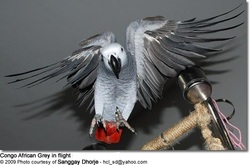
An African Grey parrots lifespan is around 60 years. This is something which must be considered when purchasing one as a pet. It is a well known fact that these birds are highly intelligent creatures and should they not be condemmed to a unhappy life shut away in a cage. African greys live in large flocks in the wild where they will spend their days communicating with others and foraging for food. They have very social personalities and this is the key to what makes them great pets! A bird that is left to spend its life shut away in a cage will become a stressed unhappy bird. 'Yes' sometimes birds kept in a cage can make great talkers- simply because listening is all they can do while spending long boring days behind bars! But is this the life they deserve? By allowing your bird free time out of the cage you are allowing it to be social, most Greys will love you for this and make a strong loving bond to you, their human partners. They are natural lovers and in the wild will choose a partner and bond for life-you are that substitute! Imagine the stress of being locked away for your whole life without even a hug!-It is the same for parrots! Freedom also allows your bird to participate in natural behaviour such as foraging. In the wild they will spend many hours of the day looking for food, bathing and playing. Finding your food next to you in a pot each day really is no fun! These birds need the constant stimulation to keep their minds alert and active, you cannot take away these natural instincts even from a hand reared bird who has never been in the wild. Outside cage activity is also essential for your birds health. A bird is made up of a very complex muscular system. If they do not get to exercise their wings and other muscles they can become very poorly and muscle and joint problems as well as circlulation problems can occur. If a bird is in one spot all day surrounded by its own mess, however clean you try to keep them, bacterial and fungal infections can set in too. Caged African Greys are also prime candidates for feather plucking. This usually occurs because the bird is stressed and unable to carry out its natural instincts or simply because they are bored. It is very difficult to stop this once it has begun as it becomes habit for the 'bored' bird.
So to sum up you really need to ask yourself "is an African Grey the right pet for me?". If you are at work all day and your bird is alone and shut in its cage all the time then the answer is 'NO'. If you are unable to provide your bird with out of cage activities maybe because you don't want a bit of mess or you are afraid of things being chewed- Then the answer is 'NO'. If you have other pets that could harm your bird and cannot be kept away while your Grey has some out of cage time- then the answer is 'NO'. If you are afraid of letting your grey out of the cage because you are unable to supervise young children that are around then once again the answer is 'NO'. Taking on an African Grey is hard work but very rewarding if done right. The worse thing you can ever do is condem your Grey to a life in a cage. If your situation changes and you are unable to allow your bird the 'out of cage time' it once had then maybe for your birds sake it is wiser to provide your bird with a new home which can provide your bird with the love and attention it needs and deserves.
Please think of your Greys well being, they are clever birds but are not clever enough to speak out and tell you how they are feeling and as I said at the beginning they have a very long life- please make it a happy one for them! Thankyou- Christine :)
So to sum up you really need to ask yourself "is an African Grey the right pet for me?". If you are at work all day and your bird is alone and shut in its cage all the time then the answer is 'NO'. If you are unable to provide your bird with out of cage activities maybe because you don't want a bit of mess or you are afraid of things being chewed- Then the answer is 'NO'. If you have other pets that could harm your bird and cannot be kept away while your Grey has some out of cage time- then the answer is 'NO'. If you are afraid of letting your grey out of the cage because you are unable to supervise young children that are around then once again the answer is 'NO'. Taking on an African Grey is hard work but very rewarding if done right. The worse thing you can ever do is condem your Grey to a life in a cage. If your situation changes and you are unable to allow your bird the 'out of cage time' it once had then maybe for your birds sake it is wiser to provide your bird with a new home which can provide your bird with the love and attention it needs and deserves.
Please think of your Greys well being, they are clever birds but are not clever enough to speak out and tell you how they are feeling and as I said at the beginning they have a very long life- please make it a happy one for them! Thankyou- Christine :)
Getting to know your African Grey
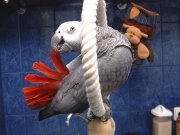
Getting to know your African Grey Parrot by observing and better understanding its body language will help develop a long-lasting strong and trusting relationship. African Grey Parrots can be loving and playful and then in the next moment turn demanding and standoffish. As they are very sensitive and intuitive to what is going on around them in their environment, we as their companions must also be in tune to their needs and wants.
Take the time to observe your African Grey as it plays, explores and interacts. African Grey body language, from the eyes, posture and reactions, is very telling. Birds, just like humans, have moods too!
Take the time to observe your African Grey as it plays, explores and interacts. African Grey body language, from the eyes, posture and reactions, is very telling. Birds, just like humans, have moods too!
INTRODUCING YOUR AFRICAN GREY TO THEIR NEW HOME
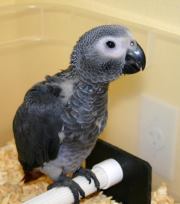
By Christine Fraser
Before you bring your African Grey home for the first time you will need to have a large clean & roomy cage set up for your birds arrival. I always recommend buying a cage with an open top stand on it as a tame bird will enjoy many hours of freedom outside the cage and will happily sit on the stand maybe popping in and out for some food or a sleep every now and then. Make sure that the feed pots are full and fresh water is also available inside the cage. Where to place the cage is very important too. You do not want to place the cage in a busy area of your home to begin with as your new bird will already have lots to take in with her new surroundings. So keep away from busy doorways and also avoid backing cage next to a window, I find backed against a wall or in a corner where the bird does not have to keep looking 360 degrees around it helps and makes it feel much more secure. Avoid kitchens and draughty spots.
When you finally bring your bird home, the manner in which you follow and the care you provide over the first few days will depend a lot on your individual bird. Sometimes people may advise you to allow a new bird to remain in her cage for the first couple of days to allow her time to get used to her new surroundings. However, if your baby has been lovingly hand fed, this is not good advice to follow. In the majority of cases, your new baby will be reassured by handling and respectful interaction. Nothing can make a hand fed baby feel more forlorn than to go to a new home and to be left in a cage for the first two days without the physical reassurance and interaction it has come to count on . On the other hand, too much activity or too many demands for interaction can also be a problem for a young bird. The first few days are NOT the time to invite all of your friends over for an introduction.
Generally speaking, Greys both old and young, should be introduced to new things in increments. When you bring a new baby home, don’t immediately show her the whole house and introduce her to every creature residing therein. Bring her in, remove her from the carrier, and with her on your hand, proceed to show her the room in which her cage stands. Just let her look around a little, talking to her all the while, explaining that she is home and that you are going to take good care of her. Once she has had a chance to view her immediate surroundings, place her on top of her cage (hopefully this has a playtop) and just let her walk around. Height will always make young parrots feel a little safer. Bring her some food right away, and some fresh water, again telling her how happy you are to have her home.
I always advise parrots be put in their cage at night time. Greys can get very stressed if they do not get enough sleep & getting your parrot in a good sleep routine is also great as parrots love routine, so its always good to put them in their cage around the same time each night if possible. Most Greys will appreciate a cover on just the top roof section of their cage too as this helps them feel secure and snug and also reminds them when the cover appears on top- its bed time!
Before you bring your African Grey home for the first time you will need to have a large clean & roomy cage set up for your birds arrival. I always recommend buying a cage with an open top stand on it as a tame bird will enjoy many hours of freedom outside the cage and will happily sit on the stand maybe popping in and out for some food or a sleep every now and then. Make sure that the feed pots are full and fresh water is also available inside the cage. Where to place the cage is very important too. You do not want to place the cage in a busy area of your home to begin with as your new bird will already have lots to take in with her new surroundings. So keep away from busy doorways and also avoid backing cage next to a window, I find backed against a wall or in a corner where the bird does not have to keep looking 360 degrees around it helps and makes it feel much more secure. Avoid kitchens and draughty spots.
When you finally bring your bird home, the manner in which you follow and the care you provide over the first few days will depend a lot on your individual bird. Sometimes people may advise you to allow a new bird to remain in her cage for the first couple of days to allow her time to get used to her new surroundings. However, if your baby has been lovingly hand fed, this is not good advice to follow. In the majority of cases, your new baby will be reassured by handling and respectful interaction. Nothing can make a hand fed baby feel more forlorn than to go to a new home and to be left in a cage for the first two days without the physical reassurance and interaction it has come to count on . On the other hand, too much activity or too many demands for interaction can also be a problem for a young bird. The first few days are NOT the time to invite all of your friends over for an introduction.
Generally speaking, Greys both old and young, should be introduced to new things in increments. When you bring a new baby home, don’t immediately show her the whole house and introduce her to every creature residing therein. Bring her in, remove her from the carrier, and with her on your hand, proceed to show her the room in which her cage stands. Just let her look around a little, talking to her all the while, explaining that she is home and that you are going to take good care of her. Once she has had a chance to view her immediate surroundings, place her on top of her cage (hopefully this has a playtop) and just let her walk around. Height will always make young parrots feel a little safer. Bring her some food right away, and some fresh water, again telling her how happy you are to have her home.
I always advise parrots be put in their cage at night time. Greys can get very stressed if they do not get enough sleep & getting your parrot in a good sleep routine is also great as parrots love routine, so its always good to put them in their cage around the same time each night if possible. Most Greys will appreciate a cover on just the top roof section of their cage too as this helps them feel secure and snug and also reminds them when the cover appears on top- its bed time!
IDENTIFICATION OF HAND REARED BIRDS-LEG RINGS
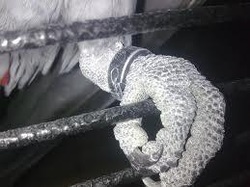
By Christine Fraser
Im often asked how you can tell if a bird is hand reared by humans. A hand reared bird will usually have a closed ring on its leg ( no split in the ring ) These rings can only be put onto the birds leg while the bird is a young chick so it is good evidence that the bird has been handled at a very young age. It is good practice for breeders to do this & most breeders will ring to proove that they have hand reared the bird. Hand reared birds are more expensive so why would they not want to proove that they are! So i always recommend checking for a closed leg ring when considering purchasing a hand reared bird. You will notice on the ring that there is various letters & numbers. The letters are usually the breeders identification & the numbers indicate the year the bird hatched, so to find out how old your grey is simply check the year on the leg ring! Split rings are not the same as a closed ring. If your bird has a ring with a split on it this indicates that the ring was put on at a much older age. They usually do not have any lettering on them but sometimes a number. These rings are usually put on while the bird is in quarentine waiting to be exported, these are usually wild caught untame birds. If there is no ring present it can be assumed that the bird is a wild caught bird too as the split rings can easily be removed where as the closed rings cannot.
Sometimes when purchasing a hand reared bird, a breeder will also give you a hatch certificate, this is great if they do as it will have details on it such as hatch date, breeder identification & sometimes tells you the sex of the bird if the breeder has chosen to have the bird DNA sexed, not all breeders will provide this but its a bonus if they do! I hope this helps, any questions feel free to ask!! :)
Im often asked how you can tell if a bird is hand reared by humans. A hand reared bird will usually have a closed ring on its leg ( no split in the ring ) These rings can only be put onto the birds leg while the bird is a young chick so it is good evidence that the bird has been handled at a very young age. It is good practice for breeders to do this & most breeders will ring to proove that they have hand reared the bird. Hand reared birds are more expensive so why would they not want to proove that they are! So i always recommend checking for a closed leg ring when considering purchasing a hand reared bird. You will notice on the ring that there is various letters & numbers. The letters are usually the breeders identification & the numbers indicate the year the bird hatched, so to find out how old your grey is simply check the year on the leg ring! Split rings are not the same as a closed ring. If your bird has a ring with a split on it this indicates that the ring was put on at a much older age. They usually do not have any lettering on them but sometimes a number. These rings are usually put on while the bird is in quarentine waiting to be exported, these are usually wild caught untame birds. If there is no ring present it can be assumed that the bird is a wild caught bird too as the split rings can easily be removed where as the closed rings cannot.
Sometimes when purchasing a hand reared bird, a breeder will also give you a hatch certificate, this is great if they do as it will have details on it such as hatch date, breeder identification & sometimes tells you the sex of the bird if the breeder has chosen to have the bird DNA sexed, not all breeders will provide this but its a bonus if they do! I hope this helps, any questions feel free to ask!! :)
COURTSHIP AND HOSTILE DISPLAY
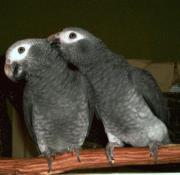
Parrots are monogamous and woo their mates not only at the onset of mating season but express mutual affection at other times as well. However, threatening gestures are part of flock life and this kind of display is an integral part of an African Grey's behaviour so it is not surprising that it also turns up in captive kept birds. African Greys, unlike many other birds, rarely perform these instinctive acts as meaningless routines, after all they are among the most intelligent of birds, and they need a partner to make the full extent of interplay possible. If your bird has formed a special bond with a member of its human familly, it will pick the person to demonstrate its affections in wooing as well as intimidating actions. Feeding the chosen person partially digested seeds choked up from the crop is such a proof of love, as are gentle nibbling on hands and earlobes, careful cleaning of the cheeks, or the unmistakable request for attention which is expressed by the beaks repeated knocking against an object. Respond to your 'Greys' offers of affection as often and as much enthusiasm as possible, this is the only way to make up for the absence of natural partners.
BEHAVIOR ISSUES
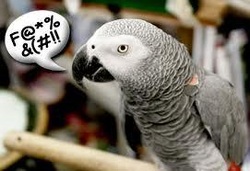
African greys study their humans, right down to the minute detail. They learn what works and they will repeat a certain behavior, as long as it gets them attention. It doesn’t matter whether it is positive or negative attention; therefore, it is important to be clear about the kind of attention you are giving to your bird. Positive reinforcement works wonders with greys. Reward your bird for doing what you want it to do. A reward can be in the form of a special treat that it does not receive with its daily food, a head scritch or being taken out of the cage to go somewhere.
Greys do not respond well to punishment. All it takes is one fearful incident to trigger a grey into a phobic reaction. Do not force your bird to do something or chase it. One of the biggest causes of phobia in greys is when their humans chase them on the floor to cuddle them after a fall. The bird becomes terrified and associates its owner as a predator. Instead, wait until the bird turns toward you, asking to be picked up. If your grey becomes terrified of something you’re wearing, leave the room immediately and remove the piece of clothing before approaching the bird.
Greys do not respond well to punishment. All it takes is one fearful incident to trigger a grey into a phobic reaction. Do not force your bird to do something or chase it. One of the biggest causes of phobia in greys is when their humans chase them on the floor to cuddle them after a fall. The bird becomes terrified and associates its owner as a predator. Instead, wait until the bird turns toward you, asking to be picked up. If your grey becomes terrified of something you’re wearing, leave the room immediately and remove the piece of clothing before approaching the bird.
Wild-caught African Greys
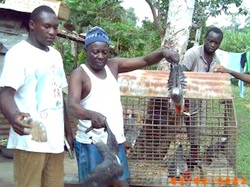
By Christine Fraser
Buying a tame hand reared young parrot is undoubtably the best way forward. But for whatever reason, some of us will end up being sold a wild African Grey - otherwise known as a 'Growler' due to the horrific growling noise these wild birds make when they are scared and defensive.
Trapping, capturing and selling these birds is illegal but some of these birds do find their way into pet stores and bird markets. If your bird 'growls' and has a split leg band or no leg band present, then chances are it is either 'wild' or 'parent reared'. Parent reared birds are birds which have been left to be reared by their parents, often in an enclosure with little or no human contact. These birds will also be wild as they would have inherited all of their natural instincts from the parent birds and therefore fear humans. Although not illegal, these parent reared birds are also not a good purchase.
There are problems which arise from purchasing wild caught African Grey's. Firstly they are very difficult to tame and train. It can take an extremely long time to gain the trust of these birds and this will take a lot of time and patience! Going in with the heavy handed - by force approach really does more harm than good.
African Grey's which are wild caught are also likely to carry disease and illness. When you buy one of these birds there is no guarantee
on health. Some diseases they carry can also be harmful to humans, other diseases, viruses, bacteria's and fungals can also harm any existing birds or pets you may also have, so it is essential that these birds are quarentined and kept away from other pets for a period of time when you purchase them, incase any syptoms of sickness begin to show. Even after a quarentine period of at least a month, there is no gaurantee that these birds are healthy as many diseases such as PBFD can lay silent inside your bird for months or maybe years!
Another thing to consider when buying these birds 'as a bargin' is that they may be cheap to buy, but what will happen if further down the line your bird becomes sick? Would you have access to an Avian Vet? could you afford the huge expense of getting your bird well again? - vet bills don't come cheap! Imagine becoming so attatched to your 'Grey' and having to watch it die in front of your eyes as you could not get the appropriate treatment for it! - Is that really being a good pet owner? Can you imagine suffering if you were denied a lifetime with no acsess to medical treatment?
Greys are also expensive to feed, Its not a simple case of putting your bird in a cage with some seeds and water. Greys require a healthy diet of fresh fruit and vegetables to keep them healthy. They also require a large cage/stand and travel carrier for trips to the vets. The food, equipment and cage often costs more than the bird itself! so Buying a cheap grey is the easy bit! Are you really saving money when there is a high chance that you may be buying a sick bird which will need lots of veterinary treatment?
There are lots of things to consider when buying these birds and you should never buy any bird without considering all the facts first- never buy on a whim or out of sympathy for these birds as all the seller will do is go and illegally trap more birds to meet the demand. Remember the people that are selling these 'Wild Grey's' are corrupt, they have no issues over selling you a sick mistreated bird and what may seem like a 'good deal' at the time could potentially turn out to be a disaster and these people will not refund you your money if the bird becomes sick or even worse dies. Many of these birds die within the first few weeks of purchasing them due to stress and the poor way in which they are handled by the corrupt trappers and sellers and most will be in contact with other sick birds, housed in filthy surroundings and fed a poor diet if any.
Please consider all of these facts before purchasing a wild caught African Grey. These sellers are illegal and do not care about the well being of these beautiful creatures which are cruely snatched from the wild, They are only interested in money and will make it at any cost. Look at the way these 'Greys' are being handled in this picture below- would you ever trust a human if your first experience of them was being abused like this?
Buying a tame hand reared young parrot is undoubtably the best way forward. But for whatever reason, some of us will end up being sold a wild African Grey - otherwise known as a 'Growler' due to the horrific growling noise these wild birds make when they are scared and defensive.
Trapping, capturing and selling these birds is illegal but some of these birds do find their way into pet stores and bird markets. If your bird 'growls' and has a split leg band or no leg band present, then chances are it is either 'wild' or 'parent reared'. Parent reared birds are birds which have been left to be reared by their parents, often in an enclosure with little or no human contact. These birds will also be wild as they would have inherited all of their natural instincts from the parent birds and therefore fear humans. Although not illegal, these parent reared birds are also not a good purchase.
There are problems which arise from purchasing wild caught African Grey's. Firstly they are very difficult to tame and train. It can take an extremely long time to gain the trust of these birds and this will take a lot of time and patience! Going in with the heavy handed - by force approach really does more harm than good.
African Grey's which are wild caught are also likely to carry disease and illness. When you buy one of these birds there is no guarantee
on health. Some diseases they carry can also be harmful to humans, other diseases, viruses, bacteria's and fungals can also harm any existing birds or pets you may also have, so it is essential that these birds are quarentined and kept away from other pets for a period of time when you purchase them, incase any syptoms of sickness begin to show. Even after a quarentine period of at least a month, there is no gaurantee that these birds are healthy as many diseases such as PBFD can lay silent inside your bird for months or maybe years!
Another thing to consider when buying these birds 'as a bargin' is that they may be cheap to buy, but what will happen if further down the line your bird becomes sick? Would you have access to an Avian Vet? could you afford the huge expense of getting your bird well again? - vet bills don't come cheap! Imagine becoming so attatched to your 'Grey' and having to watch it die in front of your eyes as you could not get the appropriate treatment for it! - Is that really being a good pet owner? Can you imagine suffering if you were denied a lifetime with no acsess to medical treatment?
Greys are also expensive to feed, Its not a simple case of putting your bird in a cage with some seeds and water. Greys require a healthy diet of fresh fruit and vegetables to keep them healthy. They also require a large cage/stand and travel carrier for trips to the vets. The food, equipment and cage often costs more than the bird itself! so Buying a cheap grey is the easy bit! Are you really saving money when there is a high chance that you may be buying a sick bird which will need lots of veterinary treatment?
There are lots of things to consider when buying these birds and you should never buy any bird without considering all the facts first- never buy on a whim or out of sympathy for these birds as all the seller will do is go and illegally trap more birds to meet the demand. Remember the people that are selling these 'Wild Grey's' are corrupt, they have no issues over selling you a sick mistreated bird and what may seem like a 'good deal' at the time could potentially turn out to be a disaster and these people will not refund you your money if the bird becomes sick or even worse dies. Many of these birds die within the first few weeks of purchasing them due to stress and the poor way in which they are handled by the corrupt trappers and sellers and most will be in contact with other sick birds, housed in filthy surroundings and fed a poor diet if any.
Please consider all of these facts before purchasing a wild caught African Grey. These sellers are illegal and do not care about the well being of these beautiful creatures which are cruely snatched from the wild, They are only interested in money and will make it at any cost. Look at the way these 'Greys' are being handled in this picture below- would you ever trust a human if your first experience of them was being abused like this?
Finding yourself with a wild-caught growler
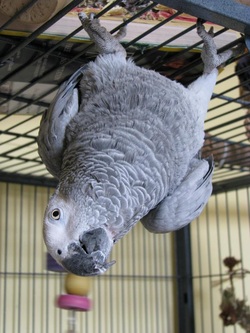
BY CHRISTINE FRASER
We have established the risks of buying wild African Grey Parrot's and I would advise anybody to buy already tame, healthy, hand-reared bird's, But we know this is not always how things are and for whatever reason some of us do end up with 'growlers'. These wild Grey's are known as 'growlers' due to the awful noise these bird's make when they are scared and approached by humans.
Imagine how scary it must be, being taken from the glorious shelter of the tree's, surrounded by the rest of your flock and other familiar creatures, going from total freedom and a natural enviroment to being imprisioned in a cage surrounded by unfamiliar scary faces in a man-made enviroment with lots of strange noises and usually no other parrot's in sight! These birds have not had the best of starts. They have been trapped and mis-handled, pulled around and shoved into baskets and cages, not knowing if they were going to survive from one minute to the next. They are fed unfamiliar foods - if any at all! and thrown around until sold to the first person to 'Flash the Cash'. Would you trust a strange unfamiliar alien creature - as humans are to these birds after being treated like this? I DON'T THINK SO!!
SO WHAT CAN WE DO TO HELP THESE BIRDS AND TO CALM THEM DOWN AND ADJUST THEM TO A LIFE IN CAPTIVITY?
If you have purchased one of these young freshly caught 'Grey's' then this article is for you. If you have a wild 'Grey' which is older and adjusted to human presence and you would like to tame it up, then the next article will be for you.
STEP 1 - The cage set-up
Your bird should be in a suitable cage, supplied with wooden perches of which your bird's feet should go 2/3 or 3/4 of the way around. If the perches are too thin, your bird will have trouble balancing on them and they may also later get foot problems. So please ensure this before placing your bird into the cage as once the bird is in there it will be very difficult to do anything to the cage without getting bitten or scaring your bird.
STEP 2 - Where to position the cage
For the first few days, your bird will be very, very scared as there will be many new things for it to take on board. New people, enviroment, sounds, temperatures, food etc. Your bird will need to feel secure and calm so that it can look and listen to everything new around it. For this reason it is important that your bird's cage should be placed in a corner of the room so that 2 sides of the cage are up against a wall. The cage should also be 3/4 covered so that only part of the cage exposed is the front of the cage. This makes it much easier for the bird to settle as it will not have to be constantly looking all around and above for anything which it may find scary. If the cage is smaller it is also a good idea to place it up high too so that the bird can look down on activities in the home. It is essential that the cage is placed away from doorways and windows as these are active areas and you bird will be forever be on gaurd waiting for somebody to pass by.
STEP 3 - Be patient
When you have all of this covered, leave your bird alone for a few days - totally ignoring that it is there and only attending to it when replacing food and water. This will give your 'Grey' time to check out the routine of the household and recognise voices. Remember everything will be scary to your bird. They will be constantly on the look out for scary items. There are no remote controls, lights, cups, tv's etc in the wilderness where they have come from, so how are they suppose to instantly know that these items are not suddenly going to jump up and attack them or explode! Everything in your home will be something new to fear and your bird will need time to check these items out and learn they have nothing to fear.
STEP 4 - Calming down
After a few days or maybe longer, your bird will calm down and the growling will ease. Gradually move towards bringing your bird into the family enviroment. For example, If you see improvement and the growling has stopped, try bringing the cage down lower to eye level, still leaving it in the corner of the room and away from doorways and window's. When your bird stops growling in the lower position, maybe after a few more days try removing the cover. When the growling stops in the uncovered position then try approaching the cage, talking quietly and calmly to your bird and avoiding sudden movements as they may unsettle it. Once you have achieved that you are ready to begin some training and taming techniques!
NOTE* - Never be tempted to grab your 'Grey' with gloves or a towel! I always say gloves are a definate 'NO' at any stage in a birds development as this will simply make your bird fearful of human hands and your bird may well never trust you again! Remember, hands will be what all wild caught birds will fear the most - after all it was these that first grabbed them and took them from their wild enviroment and probably not in a very nice manner! These trappers and sellers do not care about the bird's welfare, they only care about the money and will grab these birds by the wings, legs, tail and throw them about in anyway they can! These birds will have suffered pain from being mis-handled! Towelling your bird is fine if done correctly but should only be done when absolutely necessary as if a bird has not been trained to like the towel it will also cause the bird much distress.
Never position your African Greys cage low on the floor, they should always be kept at eye level to make them feel secure.
SUMMARY
* Make sure your cage, perches etc. are in place before your bird is caged.
*Do not place a wild 'Grey's' cage near doorways or windows
*Place the cage high up and with 3 sides covered
*Place the cage in a corner of the room
*Allow your bird to stop growling before moving on to each new step
*Never grab a 'Grey' with gloves
*Cages should always be kept off the floor so that the bird is at eye level with you.
*Talk calmly and quietly to reassure your bird. Never be tempted to shout or loose your temper.
*Do not poke things at your bird through the bars of the cage.
*Do not play loud music, tv's loud or have noisy children running around while trying to calm your bird. Some quiet background music, low tv or general chat is fine.
*Avoid any jerky or fast around your bird especially with your hands as these sudden movements will scare.
We have established the risks of buying wild African Grey Parrot's and I would advise anybody to buy already tame, healthy, hand-reared bird's, But we know this is not always how things are and for whatever reason some of us do end up with 'growlers'. These wild Grey's are known as 'growlers' due to the awful noise these bird's make when they are scared and approached by humans.
Imagine how scary it must be, being taken from the glorious shelter of the tree's, surrounded by the rest of your flock and other familiar creatures, going from total freedom and a natural enviroment to being imprisioned in a cage surrounded by unfamiliar scary faces in a man-made enviroment with lots of strange noises and usually no other parrot's in sight! These birds have not had the best of starts. They have been trapped and mis-handled, pulled around and shoved into baskets and cages, not knowing if they were going to survive from one minute to the next. They are fed unfamiliar foods - if any at all! and thrown around until sold to the first person to 'Flash the Cash'. Would you trust a strange unfamiliar alien creature - as humans are to these birds after being treated like this? I DON'T THINK SO!!
SO WHAT CAN WE DO TO HELP THESE BIRDS AND TO CALM THEM DOWN AND ADJUST THEM TO A LIFE IN CAPTIVITY?
If you have purchased one of these young freshly caught 'Grey's' then this article is for you. If you have a wild 'Grey' which is older and adjusted to human presence and you would like to tame it up, then the next article will be for you.
STEP 1 - The cage set-up
Your bird should be in a suitable cage, supplied with wooden perches of which your bird's feet should go 2/3 or 3/4 of the way around. If the perches are too thin, your bird will have trouble balancing on them and they may also later get foot problems. So please ensure this before placing your bird into the cage as once the bird is in there it will be very difficult to do anything to the cage without getting bitten or scaring your bird.
STEP 2 - Where to position the cage
For the first few days, your bird will be very, very scared as there will be many new things for it to take on board. New people, enviroment, sounds, temperatures, food etc. Your bird will need to feel secure and calm so that it can look and listen to everything new around it. For this reason it is important that your bird's cage should be placed in a corner of the room so that 2 sides of the cage are up against a wall. The cage should also be 3/4 covered so that only part of the cage exposed is the front of the cage. This makes it much easier for the bird to settle as it will not have to be constantly looking all around and above for anything which it may find scary. If the cage is smaller it is also a good idea to place it up high too so that the bird can look down on activities in the home. It is essential that the cage is placed away from doorways and windows as these are active areas and you bird will be forever be on gaurd waiting for somebody to pass by.
STEP 3 - Be patient
When you have all of this covered, leave your bird alone for a few days - totally ignoring that it is there and only attending to it when replacing food and water. This will give your 'Grey' time to check out the routine of the household and recognise voices. Remember everything will be scary to your bird. They will be constantly on the look out for scary items. There are no remote controls, lights, cups, tv's etc in the wilderness where they have come from, so how are they suppose to instantly know that these items are not suddenly going to jump up and attack them or explode! Everything in your home will be something new to fear and your bird will need time to check these items out and learn they have nothing to fear.
STEP 4 - Calming down
After a few days or maybe longer, your bird will calm down and the growling will ease. Gradually move towards bringing your bird into the family enviroment. For example, If you see improvement and the growling has stopped, try bringing the cage down lower to eye level, still leaving it in the corner of the room and away from doorways and window's. When your bird stops growling in the lower position, maybe after a few more days try removing the cover. When the growling stops in the uncovered position then try approaching the cage, talking quietly and calmly to your bird and avoiding sudden movements as they may unsettle it. Once you have achieved that you are ready to begin some training and taming techniques!
NOTE* - Never be tempted to grab your 'Grey' with gloves or a towel! I always say gloves are a definate 'NO' at any stage in a birds development as this will simply make your bird fearful of human hands and your bird may well never trust you again! Remember, hands will be what all wild caught birds will fear the most - after all it was these that first grabbed them and took them from their wild enviroment and probably not in a very nice manner! These trappers and sellers do not care about the bird's welfare, they only care about the money and will grab these birds by the wings, legs, tail and throw them about in anyway they can! These birds will have suffered pain from being mis-handled! Towelling your bird is fine if done correctly but should only be done when absolutely necessary as if a bird has not been trained to like the towel it will also cause the bird much distress.
Never position your African Greys cage low on the floor, they should always be kept at eye level to make them feel secure.
SUMMARY
* Make sure your cage, perches etc. are in place before your bird is caged.
*Do not place a wild 'Grey's' cage near doorways or windows
*Place the cage high up and with 3 sides covered
*Place the cage in a corner of the room
*Allow your bird to stop growling before moving on to each new step
*Never grab a 'Grey' with gloves
*Cages should always be kept off the floor so that the bird is at eye level with you.
*Talk calmly and quietly to reassure your bird. Never be tempted to shout or loose your temper.
*Do not poke things at your bird through the bars of the cage.
*Do not play loud music, tv's loud or have noisy children running around while trying to calm your bird. Some quiet background music, low tv or general chat is fine.
*Avoid any jerky or fast around your bird especially with your hands as these sudden movements will scare.
